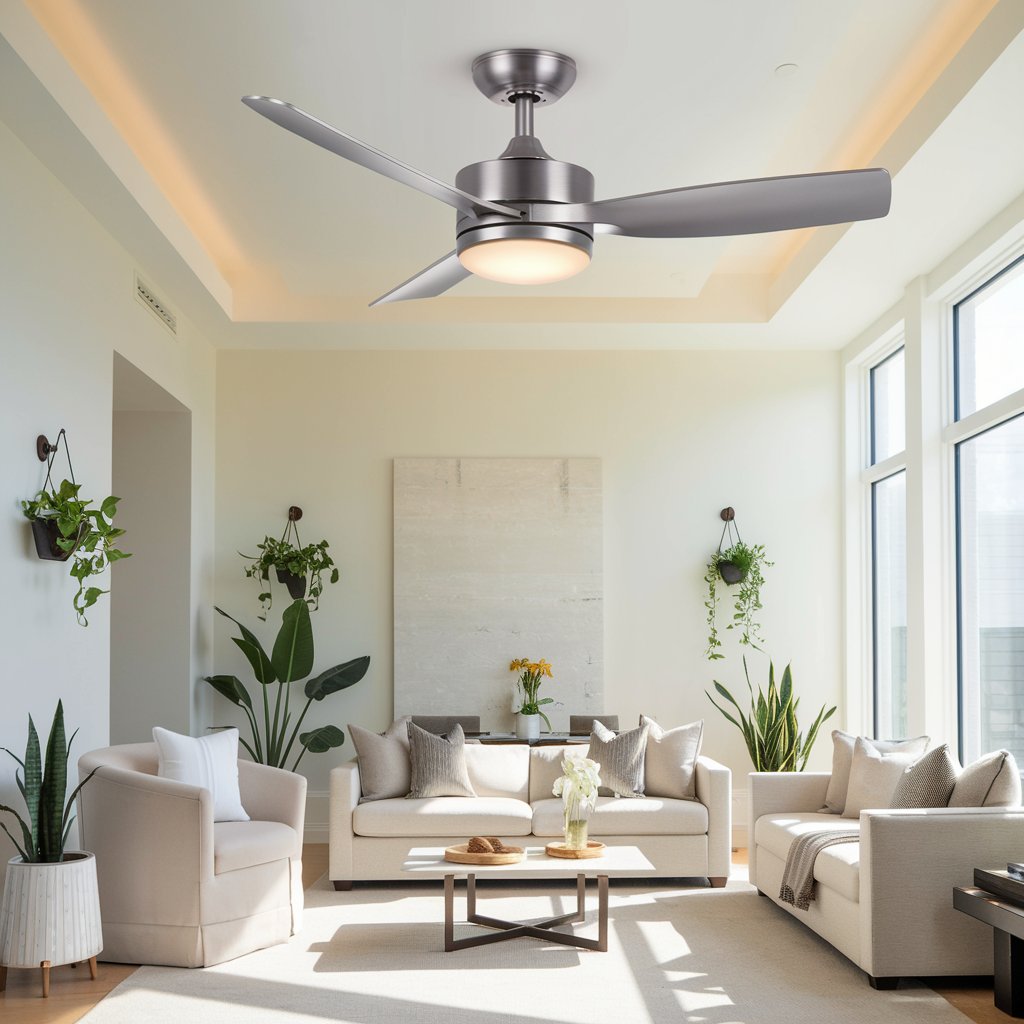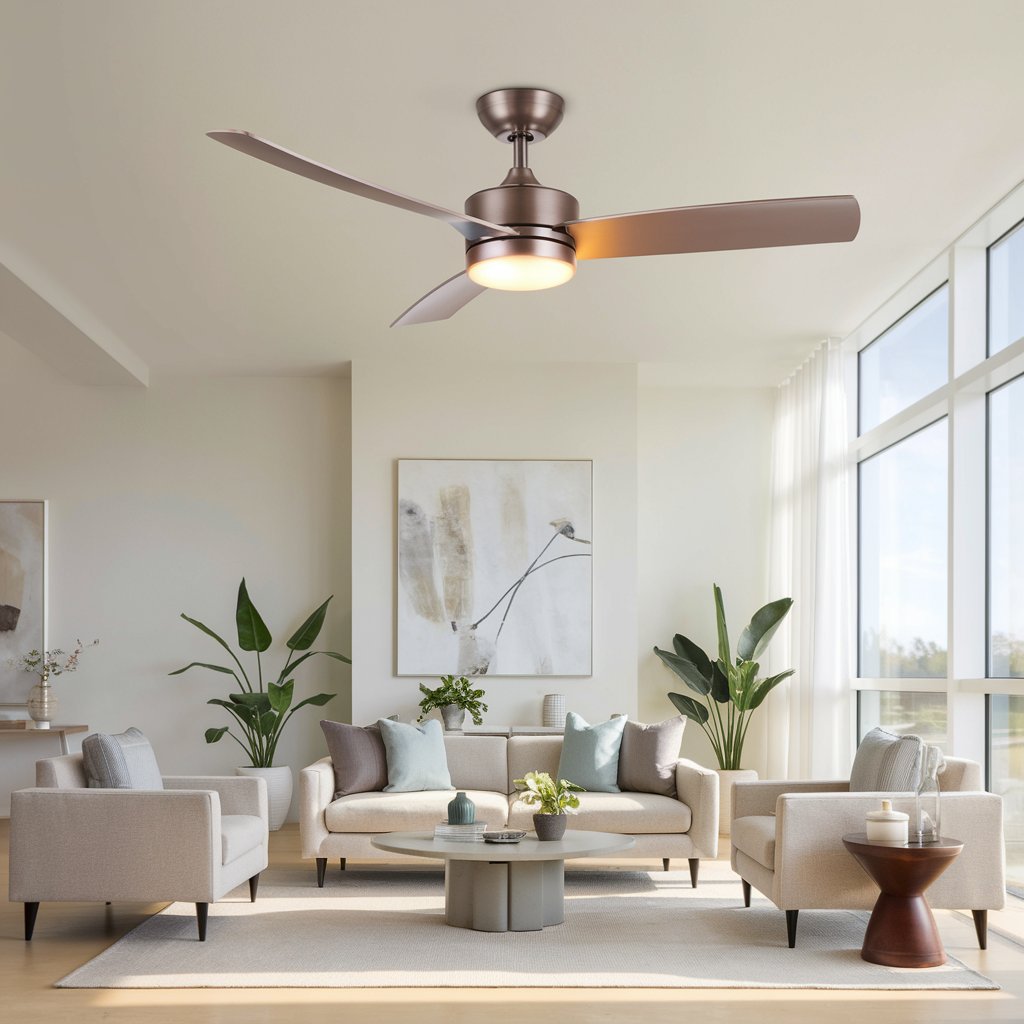Nov 18 · 5 min read
Ceiling Fan Buying Guide: Everything You Need to Know Before Making a Purchase

A ceiling fan is one of those household items that most of us take for granted. It quietly spins overhead, keeping us cool during those hot, sticky summer months. But when the time comes to replace your old fan or buy a new one for a different room, the process can feel overwhelming. With so many models, brands, and features to consider, how do you pick the right ceiling fan for your home?
To help you make an informed choice and bring home the ideal ceiling fan that fits your needs and style, this buying guide will walk you through the important considerations to keep in mind when you're looking for a new fan.
Why a Ceiling Fan?
Before we dive into the buying process, let’s take a moment to understand why ceiling fans are such a popular choice in homes. A ceiling fan does more than just circulate air; it can significantly improve the comfort of your living space by lowering the perceived temperature on hot days.
- Cool Air Circulation: Ceiling fans circulate cool air during hot weather, creating a breeze that can make the room feel several degrees cooler.
- Energy-Efficiency: Ceiling fans are energy-efficient compared to air conditioners, using much less power while still improving comfort.
- Year-Round Use: Many modern ceiling fans come with reversible motors, meaning you can use them in both summer and winter. In winter, the fan can circulate warm air trapped near the ceiling, keeping your home cozy.
Things to Take Into Account Before Purchasing a Ceiling Fan
When it comes to purchasing a ceiling fan, there are several factors that can affect the performance, efficiency, and aesthetic of the fan in your home. Let’s break them down:
1. Size of the Room
The size of the space where the ceiling fan will be installed is one of the most crucial factors to take into account when purchasing one. A fan too big for a small area can overpower it, while a fan too tiny for a large room will have trouble moving air about. Here is a basic guide to choosing the appropriate fan size according to the size of the room:
- Small Rooms (up to 75 sq ft): Perfect for small bedrooms, kitchens, and bathrooms. Select a fan whose blade span is between 32 and 36 inches.
- Medium Rooms (75-144 sq ft): Ideal for regular living areas, workplaces, or bedrooms. Choose fans with a blade span of 42 to 48 inches.
- Large Rooms (144-225 sq ft): For larger living rooms or dining areas. Look for fans with a 52-56 inch blade span.
- Extra Large Rooms (over 225 sq ft): Great for expansive rooms like large living areas or open concept spaces. Choose a fan with a 60-inch or more blade span.
When selecting your ceiling fan, ensure that you also leave enough clearance between the blades and the walls or ceiling. A general rule of thumb is to have at least 2 feet of clearance on all sides of the fan.
2. Ceiling Height
The height of your ceiling is another key consideration when choosing a ceiling fan. The fan should be positioned at a height that ensures optimal airflow without being too close to the ceiling or too low to the ground.
- Low Ceilings (8 feet or lower): If your room has low ceilings, a flush-mount or hugger ceiling fan is the best choice. These fans are designed to sit closer to the ceiling, allowing for better clearance in smaller rooms.
- Standard Ceilings (9 feet): Most ceiling fans are designed for rooms with standard ceiling heights, so you’ll have a wider variety of fan options to choose from.
- High Ceilings (10 feet or higher): For high ceilings, you’ll need a fan with a longer downrod to ensure the fan is positioned at the right height. This helps with optimal airflow and safety, as the fan blades should be at least 7 feet above the floor.
3. Blade Pitch and Material
The angle at which the blades are positioned is known as the blade pitch. A steeper pitch will help move more air, which is crucial. For most fans, a blade pitch of 12 to 15 degrees is ideal.
When it comes to the material, fan blades come in various options:
- Wood: Wooden blades add a warm, traditional look and can fit nicely in rustic or vintage-style rooms. However, they can be harder to clean and may not perform as well in very humid or damp areas.
- Plastic or Metal: These materials are durable, easy to clean, and more suited for humid environments like kitchens or bathrooms. They tend to be more affordable and are often found in modern designs.
The material of the fan housing (the body and motor casing) is also an important consideration. Most fans are made of metal or plastic, and some high-end models offer brass or chrome finishes for an added touch of elegance.
4. Airflow Efficiency (CFM)
When it comes to ceiling fans, airflow efficiency is crucial. This is measured in cubic feet per minute (CFM), and it represents the amount of air a fan moves. Higher CFM ratings mean better airflow and more effective cooling.
- Standard Fan: A fan with a CFM rating of 3,000-5,000 is sufficient for most small and medium-sized rooms.
- High-Efficiency Fan: For larger rooms or those that need extra cooling, look for fans with CFM ratings over 5,000.
- Energy-Efficient Fans: Many modern fans come with energy-efficient motors that allow them to move more air while using less energy. These can help you save on electricity bills over time.
5. Motor Type
The type of motor in your ceiling fan is another key factor in both performance and longevity. There are two main types of motors to consider:
- AC Motors: Most ceiling fans feature AC (alternating current) motors, which are reliable and more affordable. However, they tend to be less energy-efficient compared to DC motors.
- DC Motors: Since DC (direct current) motors are quieter, use less energy, and often last longer, they are growing in popularity. Additional features, such as more control options and speed adjustments, are frequently included with these fans.
6. Style and Design
Your ceiling fan should not only be functional but also add to the aesthetic appeal of your room. Fortunately, ceiling fans come in a wide range of styles to match any decor, from classic to modern to rustic.
- Traditional: For a vintage or classic look, go for a ceiling fan with wood blades, ornate detailing, and brass finishes.
- Modern: Sleek, minimalistic fans with metal blades, remote controls, and integrated LED lights are perfect for modern homes.
- Rustic or Industrial: Fans with wooden blades, dark finishes, and vintage designs work well in rustic, farmhouse, or industrial-style rooms.
- Contemporary: For a chic and sophisticated touch, choose fans with clean lines, neutral colors, and stylish finishes.
Click here to view the product on Amazon

Additional Features to Consider
- Lighting Options: Many ceiling fans come with integrated lights. If you’re installing the fan in a room that needs extra lighting, look for a fan with a light kit. Some fans even feature dimming capabilities, so you can adjust the lighting based on your needs.
- Remote Control and Smart Features: If you want convenience, consider fans that come with remote controls, smart home integration, or smartphone apps that let you control the fan speed, direction, and lights.
- Reversible Motor: Many modern ceiling fans come with a reversible motor that lets you change the direction of the blades. This is especially useful in the winter months when you want to circulate warm air from the ceiling.
Our Top 6 Ceiling Fan Picks
1. Hunter Fan Company 59242 Builder Plus
- Best for: Large rooms
- Features: High airflow, classic design, energy-efficient motor
- Pros: Reliable brand, sleek design, quiet operation
- Cons: Larger size may not fit small rooms
2. Minka-Aire F844-DK Light Wave
- Best for: Modern spaces
- Features: Remote control, dimmable light, contemporary design
- Pros: Stylish, versatile, quiet performance
- Cons: Pricier than basic models
3. Emerson Ceiling Fans CF765BQ
- Best for: Large living rooms or dining rooms
- Features: DC motor, modern design, energy-efficient
- Pros: High airflow, quiet, remote control
- Cons: Installation can be tricky for beginners
4. Hampton Bay 52 in. Altura Ceiling Fan
- Best for: Standard rooms
- Features: Remote control, reversible motor, integrated light kit
- Pros: Affordable, stylish, reliable performance
- Cons: Can be noisy on higher settings
5. Kichler 300143Z Ceiling Fan
- Best for: Traditional rooms
- Features: Wood blades, antique bronze finish, integrated light
- Pros: Elegant design, good airflow
- Cons: Not suitable for modern or minimalist spaces
6. Casa Vieja Ceiling Fan
- Best for: Small to medium-sized rooms
- Features: Compact size, classic style, quiet motor
- Pros: Affordable, easy to install, efficient airflow
- Cons: Lacks remote control or smart features

How Deals2Buy Can Help You
Shopping for the perfect ceiling fan can be daunting, but Deals2Buy can help make the process easier. They offer a variety of discounts, deals, and coupons for ceiling fans, so you can get the best value for your money. Whether you're looking for a basic model or a high-end design, Deals2Buy has a range of options that can save you money on your next fan purchase.
By checking out Deals2Buy before making a purchase, you can:
- Save Money: Find discounts and promo codes for popular ceiling fan brands.
- Compare Prices: Easily compare prices across different retailers to make sure you’re getting the best deal.
- Stay Informed: Get updates on seasonal sales, promotions, and limited-time offers to ensure you never miss a bargain.
With Deals2Buy, you don’t just get a great ceiling fan—you get it at a great price.
Conclusion
Choosing the perfect ceiling fan may seem like a daunting task, but by considering the factors mentioned in this guide, you’ll be able to find a fan that meets your cooling needs, fits your space, and complements your decor. From selecting the right size to choosing the right features, taking your time to research your options will ensure that your new ceiling fan serves you well for years to come.
Whether you prioritize energy efficiency, design, or airflow, there’s a fan out there that can fit your needs. Enjoy the cool breeze!

